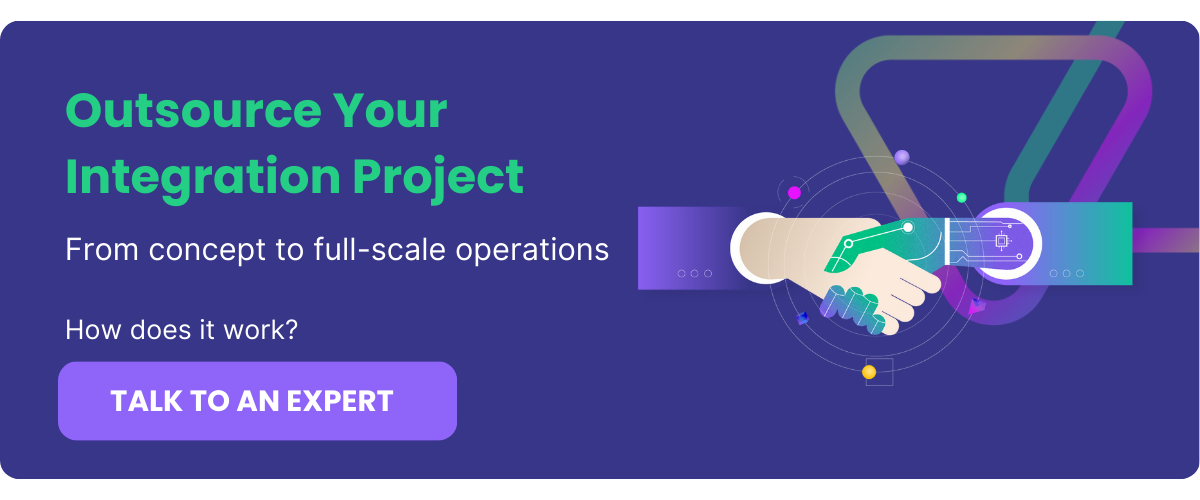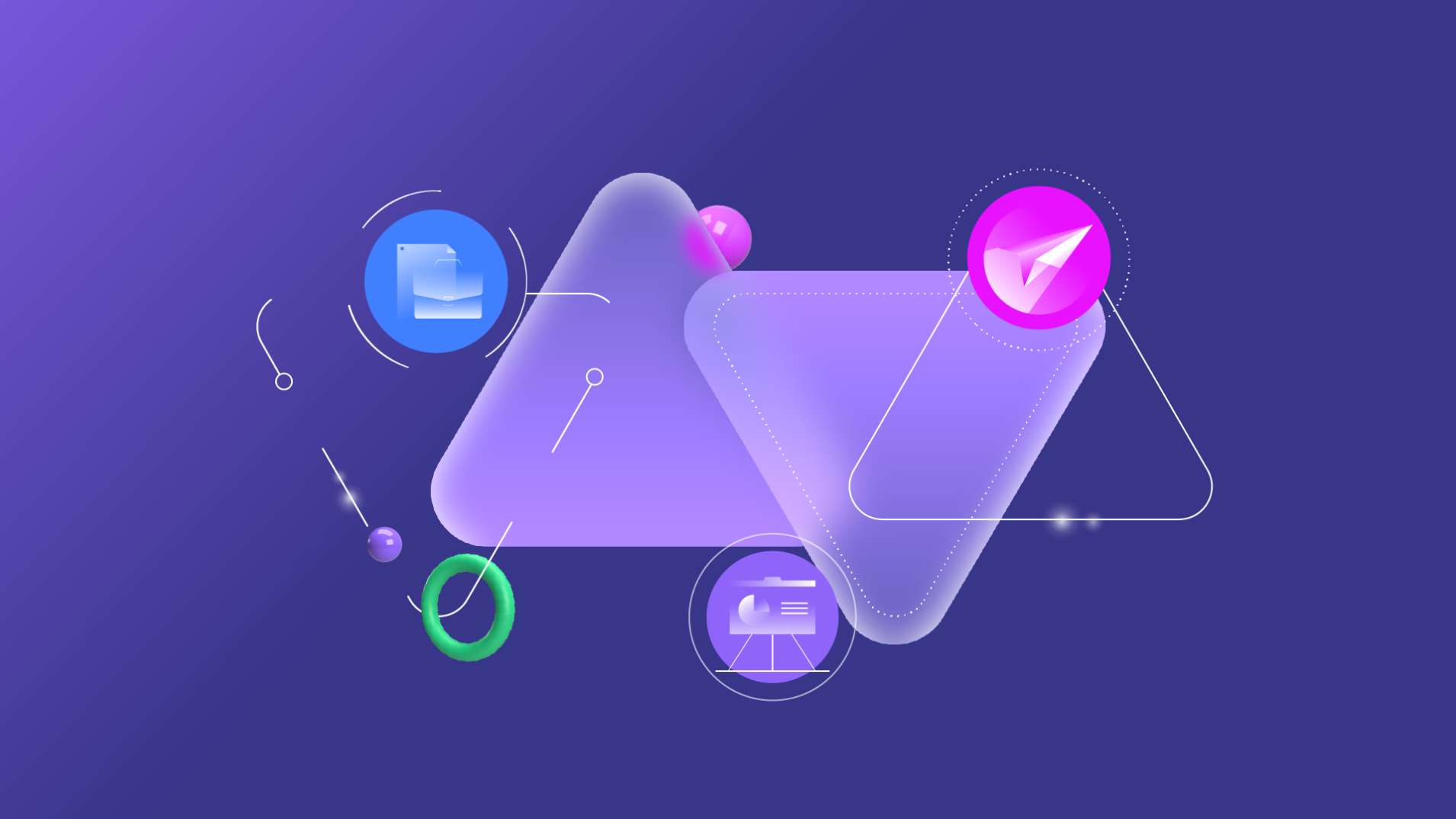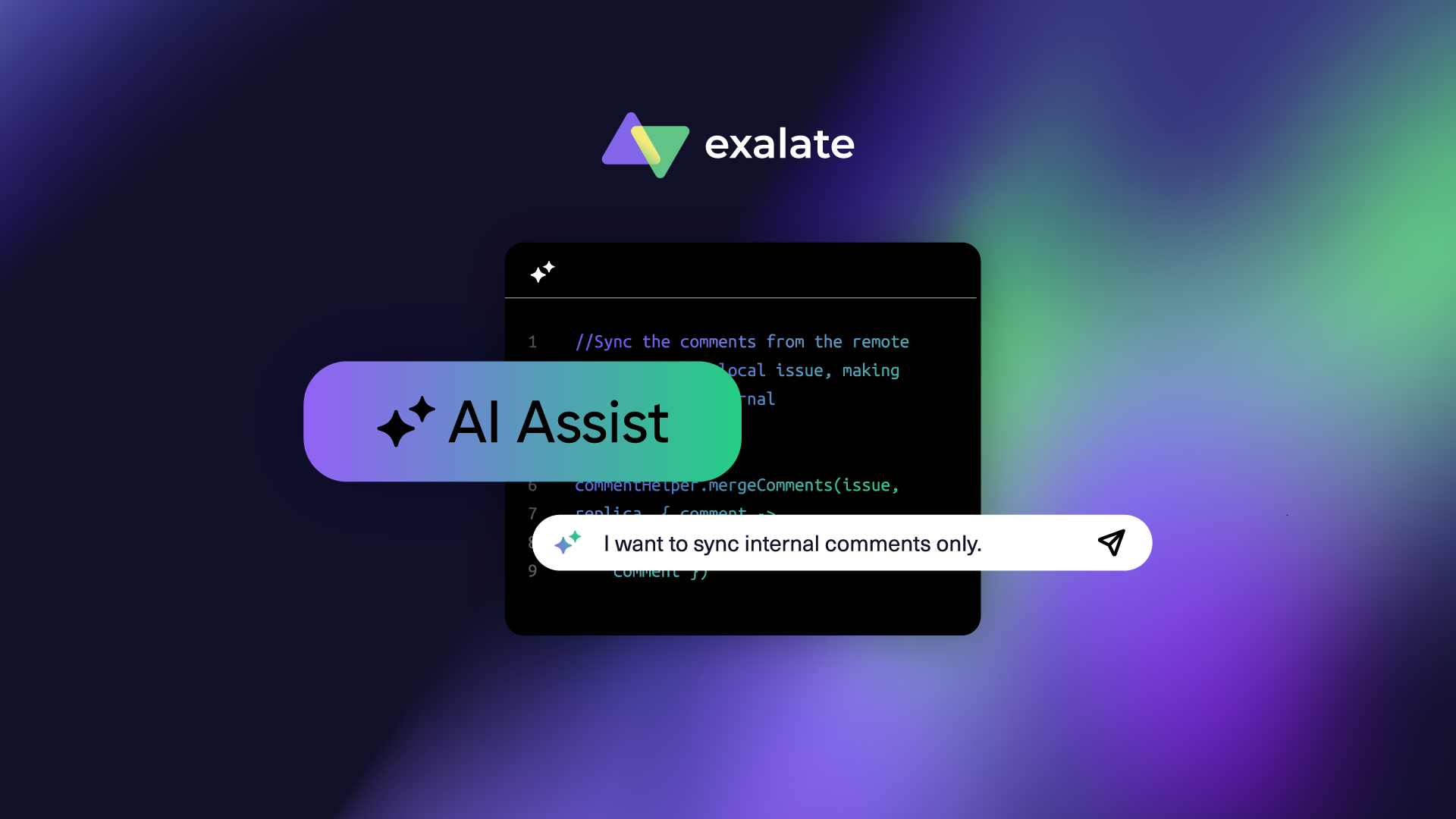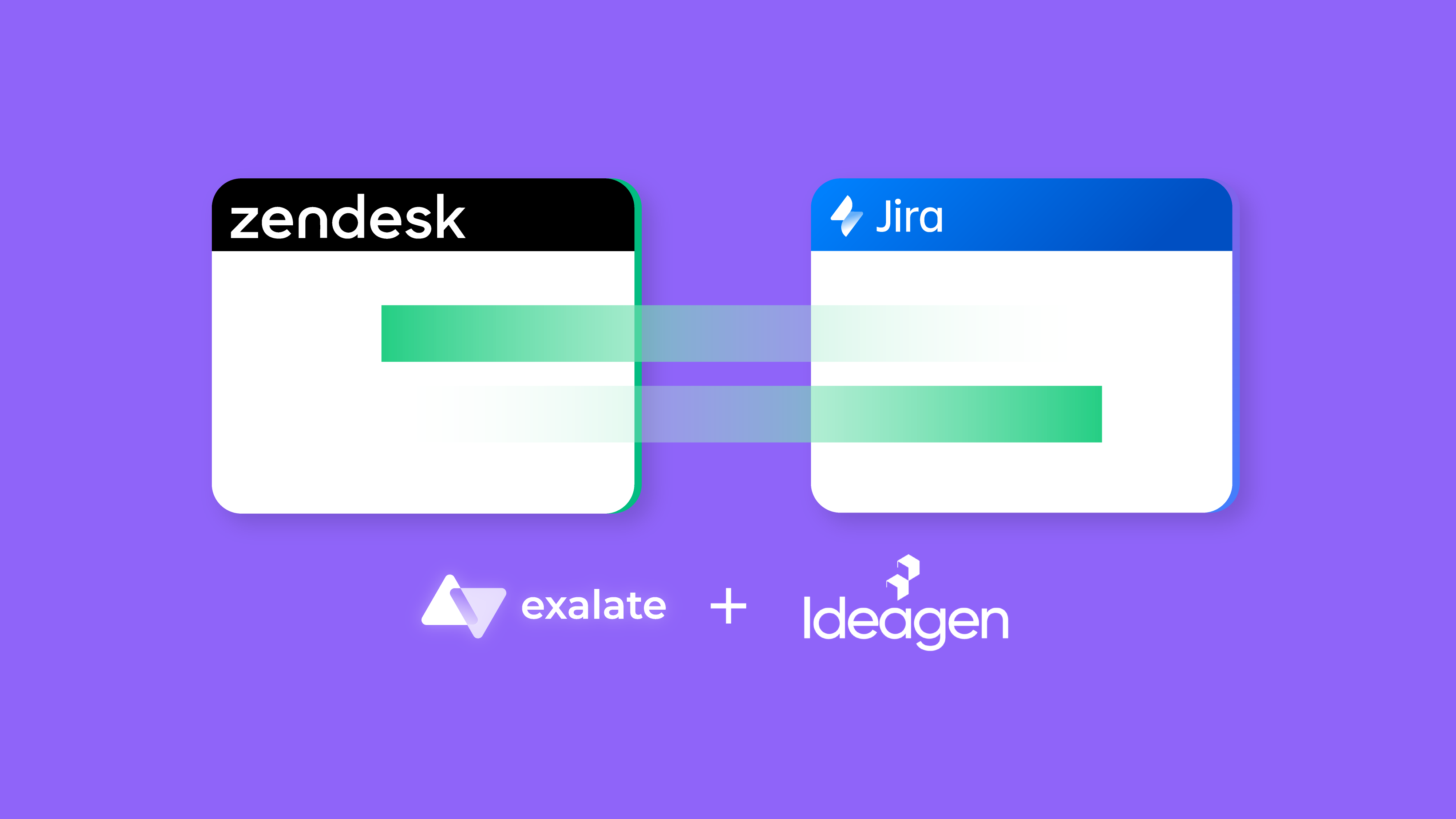The proliferation of “XaaS” acronyms and platforms reflects a complex business and cloud landscape that caters to customers with various needs and expectations. Also, the explosion of data, along with the multitude of data-driven devices, has increased the need for greater integration and synergy among diverse data sources.
Integration platform as a service (iPaaS) is a response to this dilemma. iPaaS provides a unified solution to customers by operating a set of automated tools. It facilitates the integration of data, processes, and applications by acting as a conduit of communication between disparate systems.
What is iPaaS?
iPaaS (integration platform as a service) is the process of providing a framework for building and managing integrations and API connectors.
Gartner defines iPaaS as “a suite of cloud services enabling development, execution, and governance of integration flows connecting any combination of on-premises and cloud-based processes, services, applications, and data within individual or across multiple organizations.”
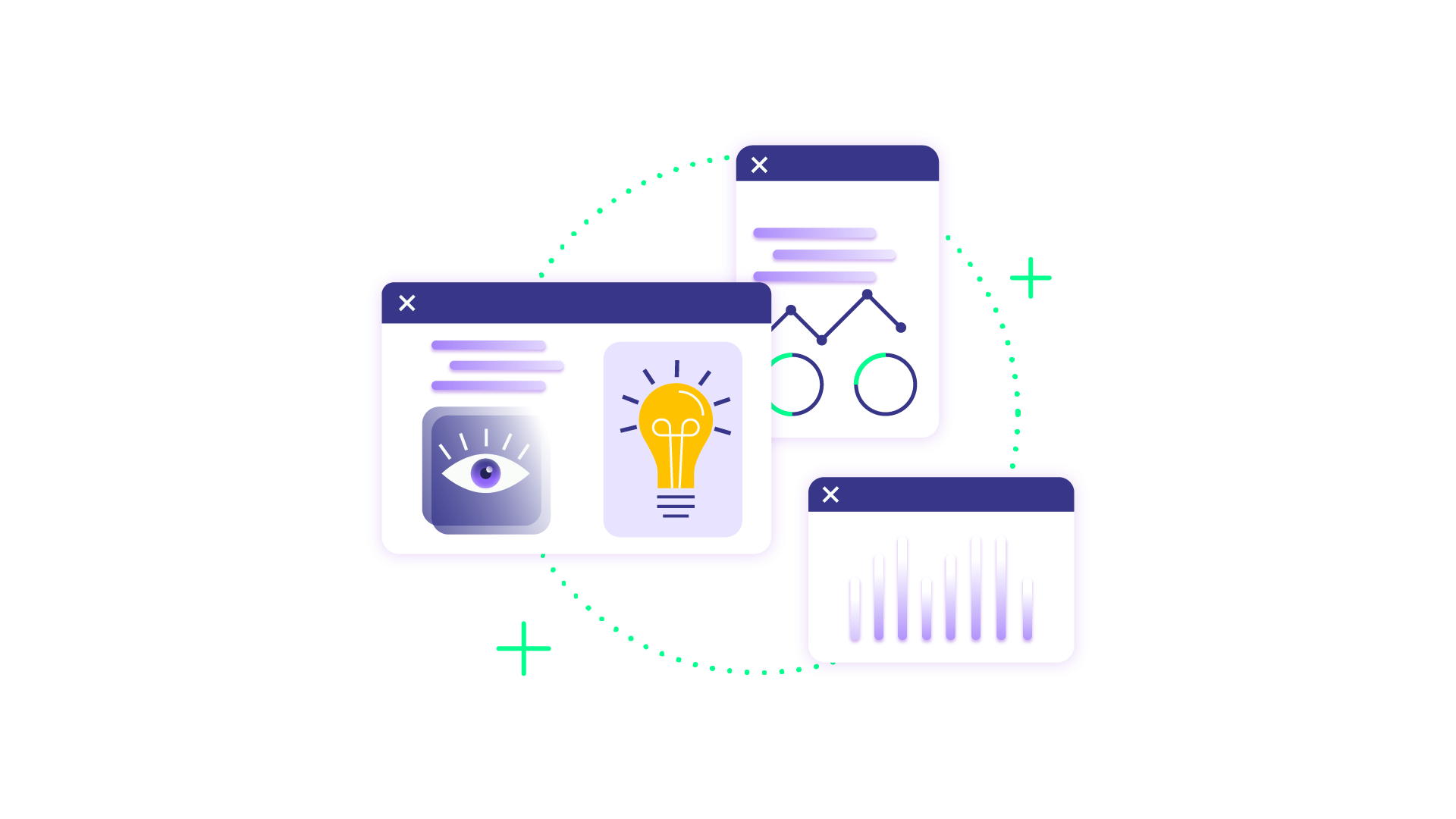
iPaaS standardizes application integration, especially by simplifying the process across on-premise and cloud environments. It provides organizations with a full IT infrastructure to reach their business transformation goals.
A Brief History of iPaaS
Although most people credit Gartner for coining the term “integration platform as a service,” it was actually first used by a Philadelphia-area company named Boomi in 2008 when it released AtomSphere.
However, Gartner further popularized the term, especially with the release of its Magic Quadrant (MQ) where it first employed the Enterprise Integration Platform as a Service (iPaaS) acronym.
Enterprise Challenges Prior to iPaaS
Integration has been a bottleneck and area of challenge for IT, especially for large enterprises. Initially, they had to make do with solutions that provided only short-term viability: custom programming, middleware implementations, and enterprise application integration (EAI) solutions.
However, these cumbersome implementations isolated data in silos and data islands, providing organizations with no visibility or point-to-point connections. Moreover, these scattered data sets were expensive to build and time-consuming to maintain.
Integration models like extract, transform, load (ETL), along with enterprise service bus (ESB) still play a role today. However, the cloud computing era has increasingly turned former solutions into relics of the past rather than indicators of the future.
As an integration middleware, ESB consists of a centralized architecture, while iPaaS is lightweight and cloud-based. ESB focuses on integrating an organization’s complex internal systems and hence guarantees vertical flexibility.
In contrast, iPaaS delivers horizontal flexibility, so it can effectively integrate fluidly with third-party applications.
iPaaS Use Cases For Enterprises
Having disjointed and misaligned information often leads to data loss, security issues, and duplicated efforts. Here are the enterprise iPaaS use cases:
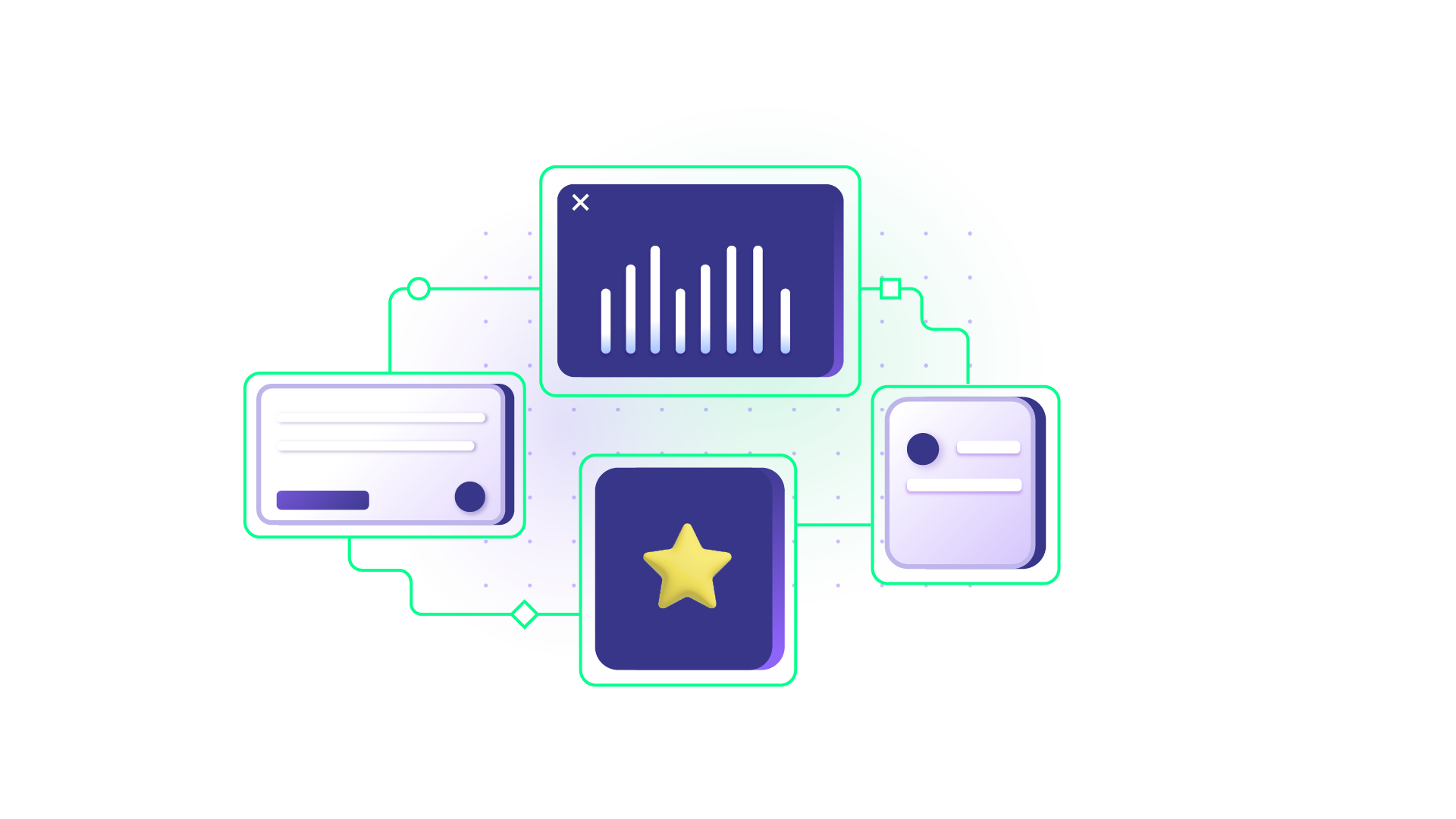
Develop Integrations for Systems
iPaaS provides users with the means to develop integration flows to connect applications, especially for non-compatible on-premise, cloud-based, and hybrid systems.
Some iPaaS solutions allow admins to use custom scripting to build connectors, while others support visual editing using drag-and-drop, pre-built connectors.
Connect Applications to Share Data
iPaaS solutions provide seamless integration between third-party applications, databases, services, CRM, and ERP systems. This could include providing better collaboration with workflows, for instance, through a Jira ServiceNow Integration.
They also execute data transformation procedures like filtering, querying, and blending data from system to system.
Sync Internal Workflows
Teams and departments within the same organization can sync workflows in order to reduce data siloes and data fragmentation through data mapping and point-to-point integration.
For instance, POSaBIT, an innovative fintech startup, used an iPaaS solution to share data from GitHub issues without manually replicating them on Salesforce. This helped both their developers and sales support team collaborate seamlessly.
Cross-company Collaborations
iPaaS provides B2B integration opportunities with the extended option to build custom, code-based solutions. These self-service capabilities enabled by iPaaS provide an efficient flow for an organization and its partners and vendors.
With iPaaS tools, enterprises can trigger and execute events based on business data, such as dispatching invoices once a project passes approval.
Insurance company Turkiye Sigorta relies on a customizable iPaaS solution to connect with external web development and suppliers.
Coordinate Mergers and Acquisitions
In highly regulated industries such as healthcare, pharma, and finance, iPaaS makes it easy to provide the much-needed secure communication between systems with cost-effective and strict compliance integration.
This becomes even more relevant during mergers and acquisitions when companies must stay in sync to smooth collaboration and transition.
How Does iPaaS Work?
To enable organizations to achieve an appreciable measure of digital transformation, iPaaS facilitates the unification of application and data integration, data preparation, workflow automation, API management, and master data management into a scalable, single, cloud-based solution.
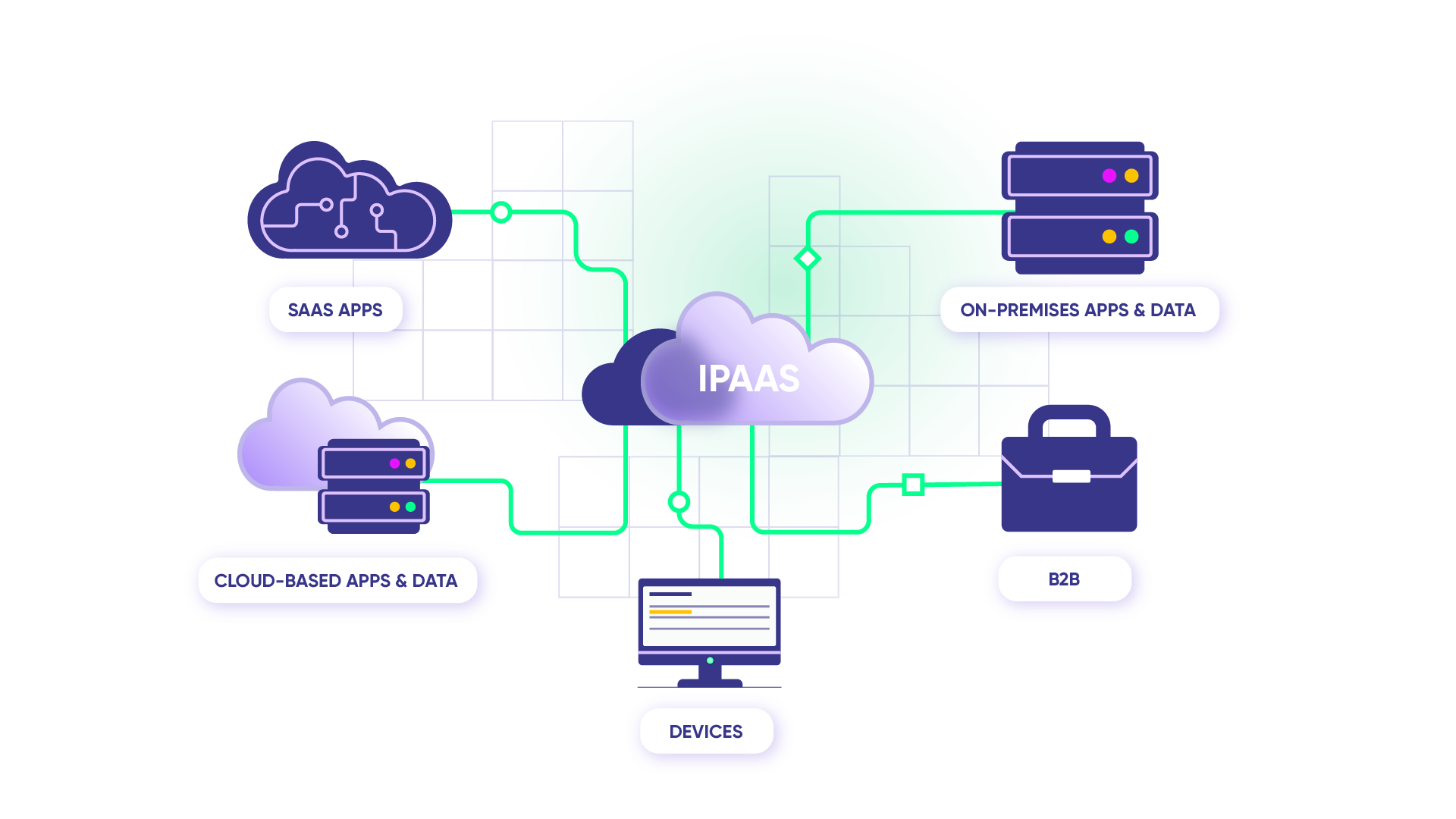
In essence, iPaaS allows companies to create, use, monitor, and build data streams without having to operate or manage their own integration platform. However, this integration platform provides more than an online set of integration tools and solutions.
This is because iPaaS is built on a full IT infrastructure, with the provider assuming responsibility for its maintenance, security, reliability, scalability, upgrades, and updates. This consequently lets customers focus on their core business.
Nevertheless, clients are responsible for configuring, mapping, and developing the requisite business processes for their organization. This provides businesses with the flexibility of working with and integrating disparate systems like CRMs and ERPs.
This flexibility also allows them to pursue a multi-cloud strategy more easily with an overarching network of cloud architectures.
What are the Differences Between PaaS and iPaaS vs SaaS and IaaS?
There are several cloud configurations, each with varying degrees of shared responsibility between the cloud service provider (CSP) and the customer:
- SaaS (Software as a Service): This is by far the most popular cloud service. Customers can use products and services (in the form of apps) through a freemium or pay-as-you-go subscription model.
- PaaS (Platform as a Service): This is an order of magnitude broader than SaaS. The CSP delivers tools to businesses and developers required for application development. This allows teams to build, host, instantiate, deploy, and run consumer-facing apps for customers.
- IaaS (Infrastructure as a Service): This platform gives an organization greater latitude to manage its resources. It delivers fundamental network, servers, compute, and data storage on-demand resources. Unlike PaaS, IaaS provides businesses with more administrative control over core computing services like operating systems.
So, the main difference between IaaS and PaaS is that the former offers customers a huge swath of the infrastructure of cloud-based technology. At the same time, PaaS empowers businesses to build customer-facing apps that are available over the cloud via APIs.
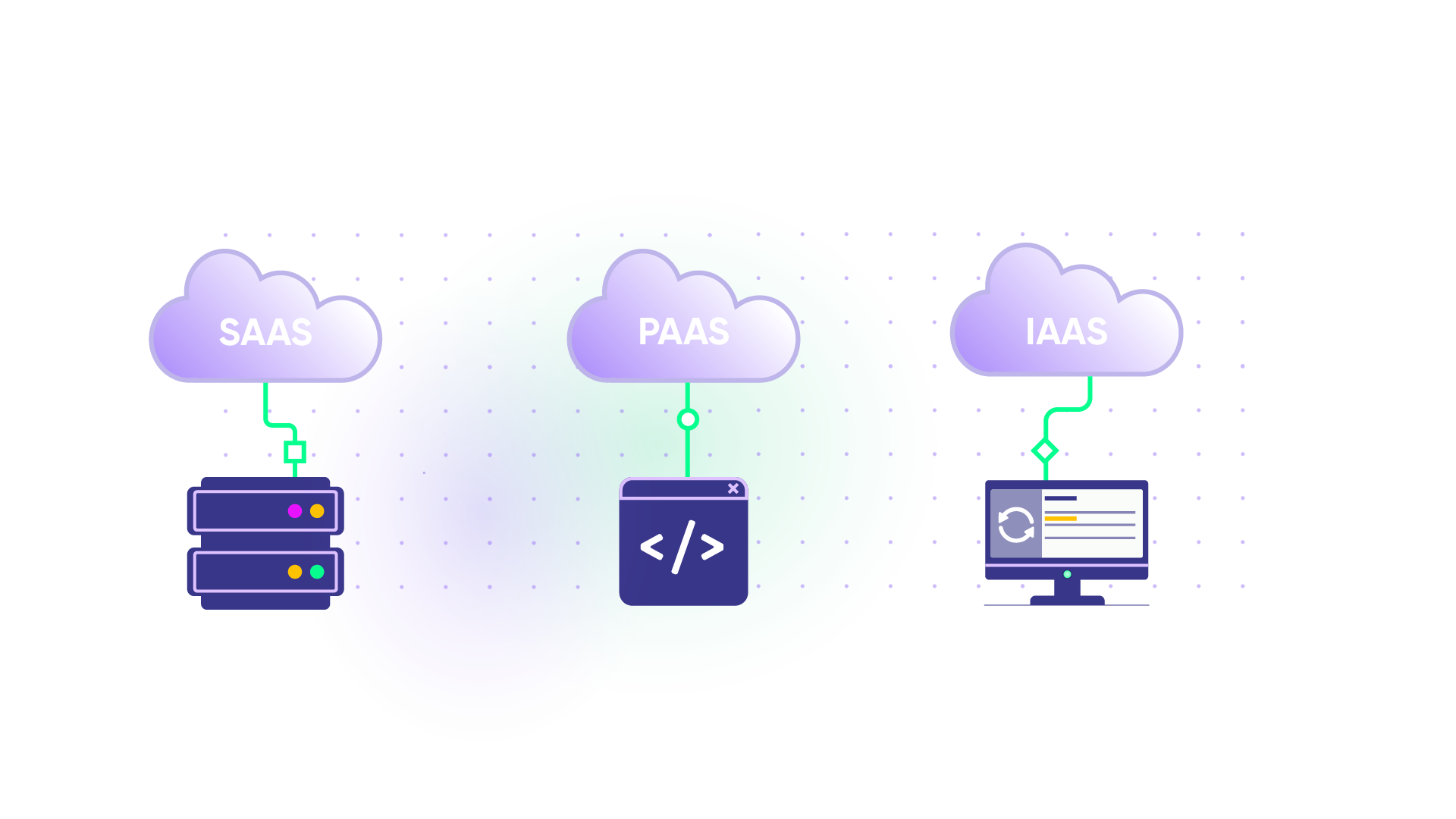
Rather than providing only a development platform, iPaaS offers the connectivity to link interfaces, websites, apps, and data sources. With iPaaS, a service provider offers customers an integration platform on a private or public cloud.
However, as a platform, PaaS is well-suited for development-focused or developer-rich organizations that have the resources and expertise to build their own data integration tools.
iPaaS is geared towards companies that juggle various off-the-shelve applications from a multitude of different vendors. iPaaS also makes less tech-savvy demands on its users and hence, can be used by teams with no coding experience.
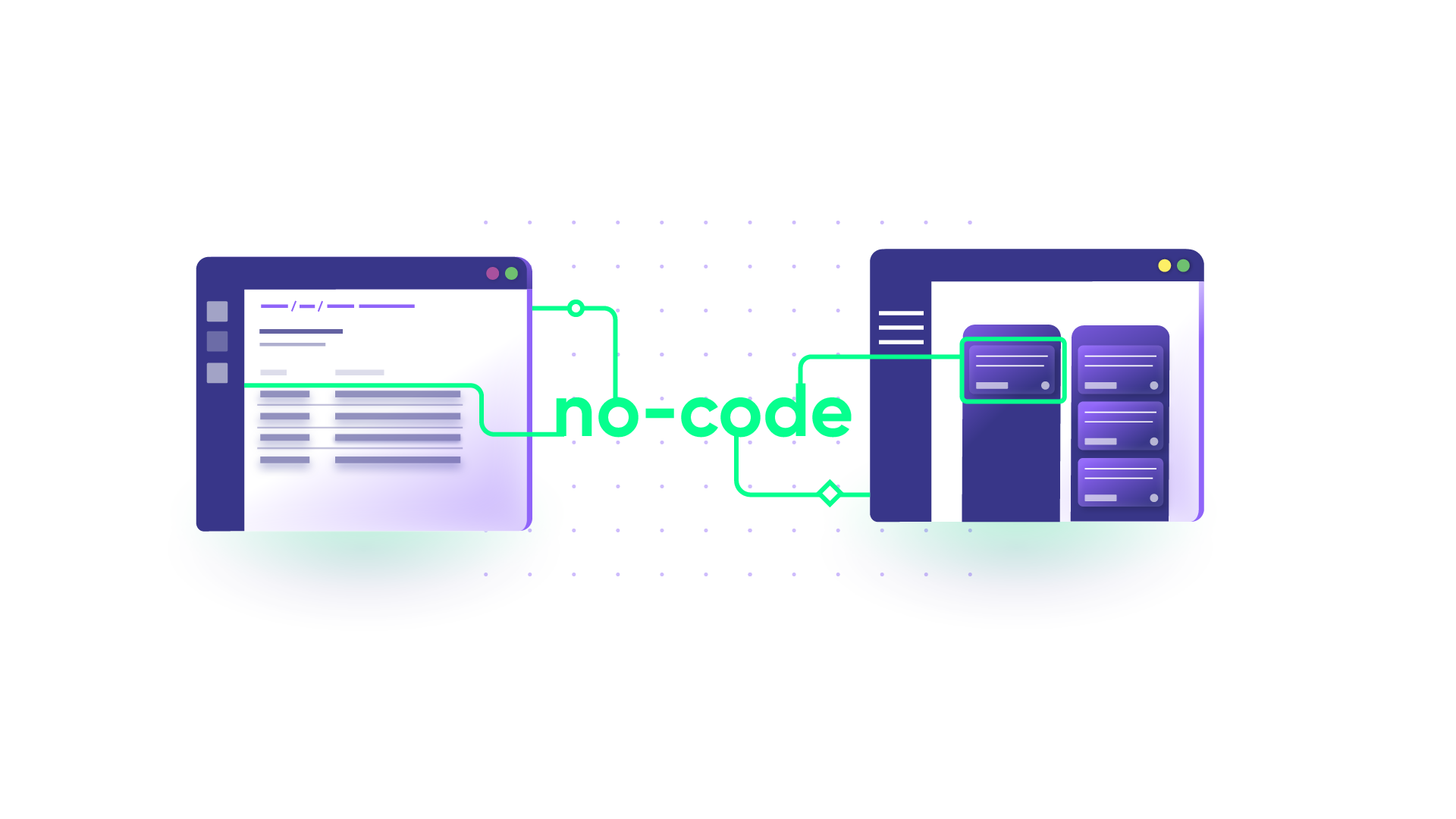
The iPaaS ecosystem is usually rich with different and diverse applications requiring integration.
The Benefits of Integrating Your App Ecosystem Through iPaaS
With businesses using dozens, if not hundreds, of applications every day, the fragmentation of critical business processes across many applications becomes inevitable and widespread, but ultimately undesirable.
Nevertheless, it is equally a waste of resources to manually move data from system to system, with all the attendant risk of errors that accompany manual processes.
Therefore, iPaaS is the only long-lasting, viable option. Here are some of the benefits businesses can reap by embracing iPaaS:
Effectively Managing and Monitoring Integrations
Most iPaaS solutions provide users with a centralized console for effectively administering integration processes. This interface makes it easy to deploy, execute, and manage integrations from a central location.
By providing a global view of integrations, DevOps teams can check the status of integrations, equally giving them more granular control to plan, start, and stop integrations with discretion.
Effective Integration Automation
iPaaS provides organizations with a way to simultaneously automate their business processes while seamlessly connecting and enabling data sharing among numerous apps.
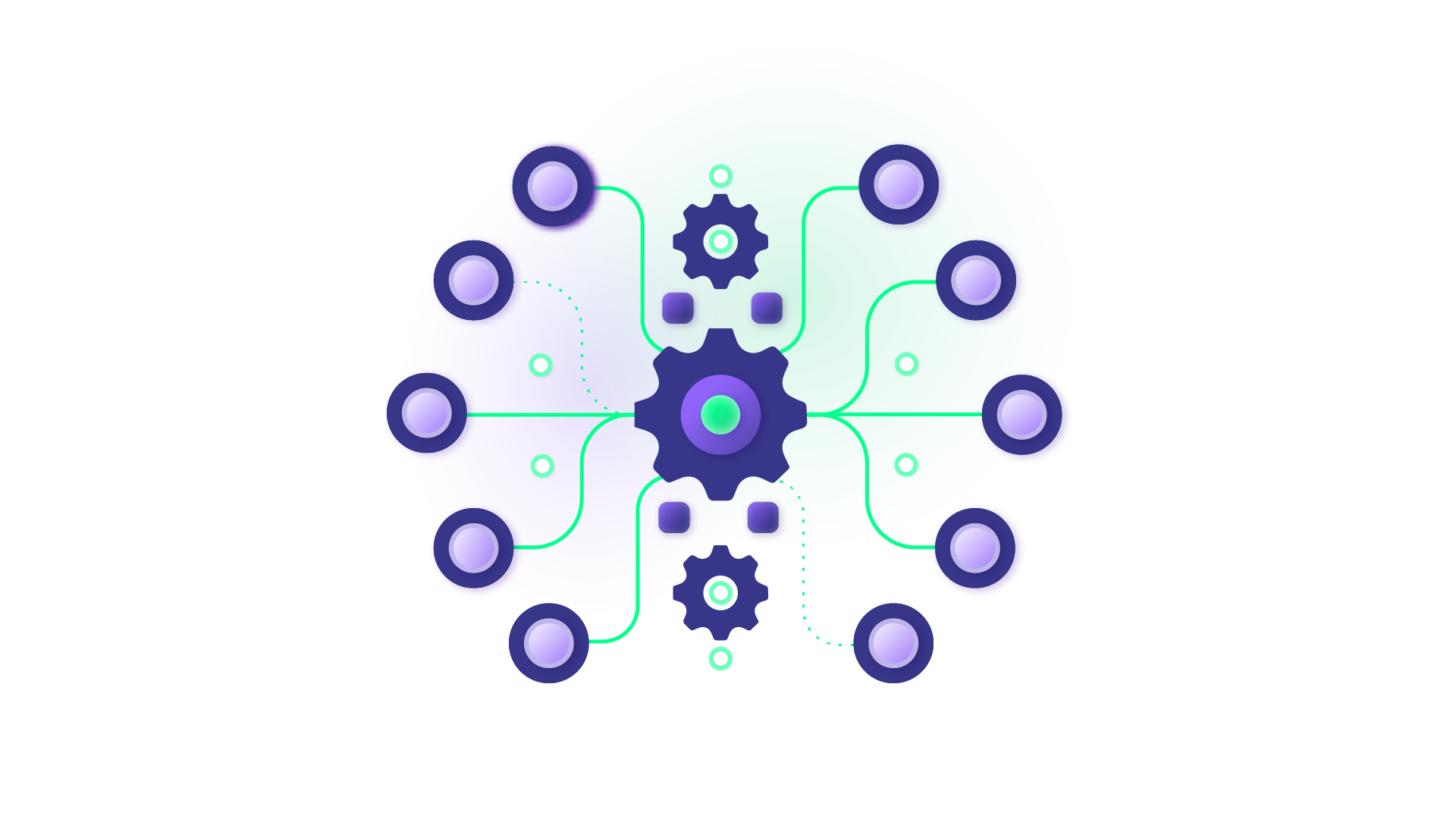
Integration has been around for some time, especially custom integration or traditional vendor-built point-to-point integration.
But these tend to lack flexibility, are labor-intensive, and frankly can’t keep up with the volume and velocity of new apps and data requests. iPaaS improves these problems with effective and efficient automation.
Improved Cost-Effectiveness
iPaaS platforms offer customers more cost and time savings compared to traditional methods used to integrate applications. With its built-in automation, scalability, and integration-focused features, customers are able to reap time and cost efficiency that yields a better value for their money.
Seamless Moving Data Between Applications
Before iPaaS, it was a nightmare for businesses, especially software teams, to move data between disparate systems. They were often compelled by incompatible formatting between data from relational databases (RDBMS) and unstructured data from social media and IoT devices to resort to manual hacks to effect integration.
This seamlessness is especially useful for cross-company integration, which allows businesses access to a network of interconnected companies.
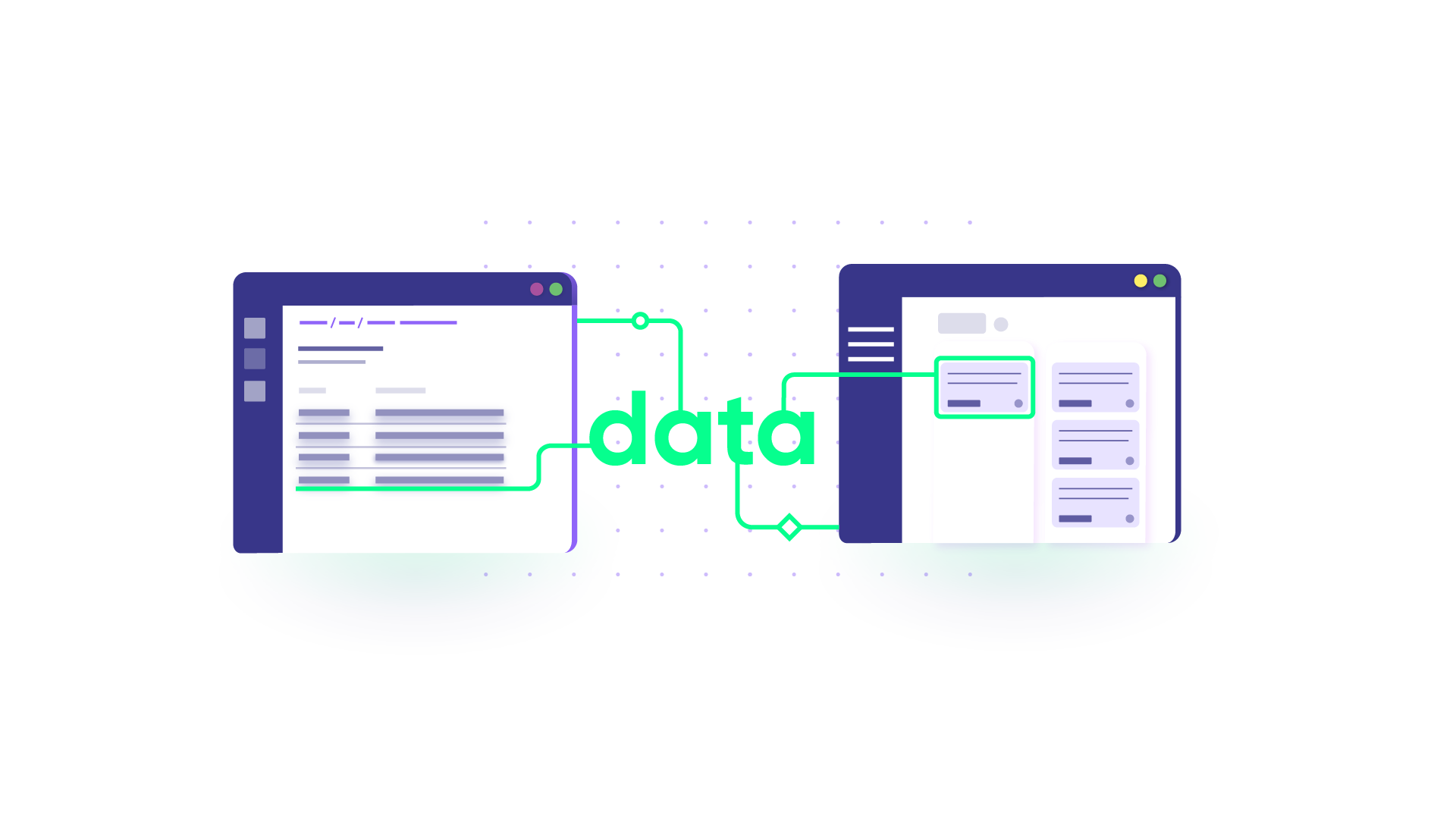
iPaaS applications are equipped with user-friendly features that allow you to export and import data with a click of a button. These customer-facing features hide the layers of abstraction and underlying difficulty involved while they make data integration a cinch for customers.
With iPaaS tools, organizations can quickly proceed to create seamless integration with little or no low overhead. These usually require less coding, intermediate tools, and technical expertise.
For example, providing users with the interfaces and tools to set up a Jira Salesforce Integration.
Improved Data Accessibility and Customer Experience
In addition to providing much-needed integration services, iPaaS also improves data accessibility for organizations. iPaaS offers companies a central repository and location for accessing their integrated data.
This improved data accessibility also enhances productivity with real-time data processing and sharing. In addition, this reduces latency and delays in accessing data, further improving the overall customer experience.
By standardizing and setting rules for how data is accessed, iPaaS solutions improve the predictability of their platforms. This is a boon for businesses who like reliability because it enables them to plan and predict product and customer behavior.
The Different Types of iPaas Providers
There are three broad categories under which iPaaS providers fall, namely: cloud integration, Enterprise Service Bus (ESB) and Service-Oriented Architecture (SOA) infrastructure, and e-commerce and B2B integration.
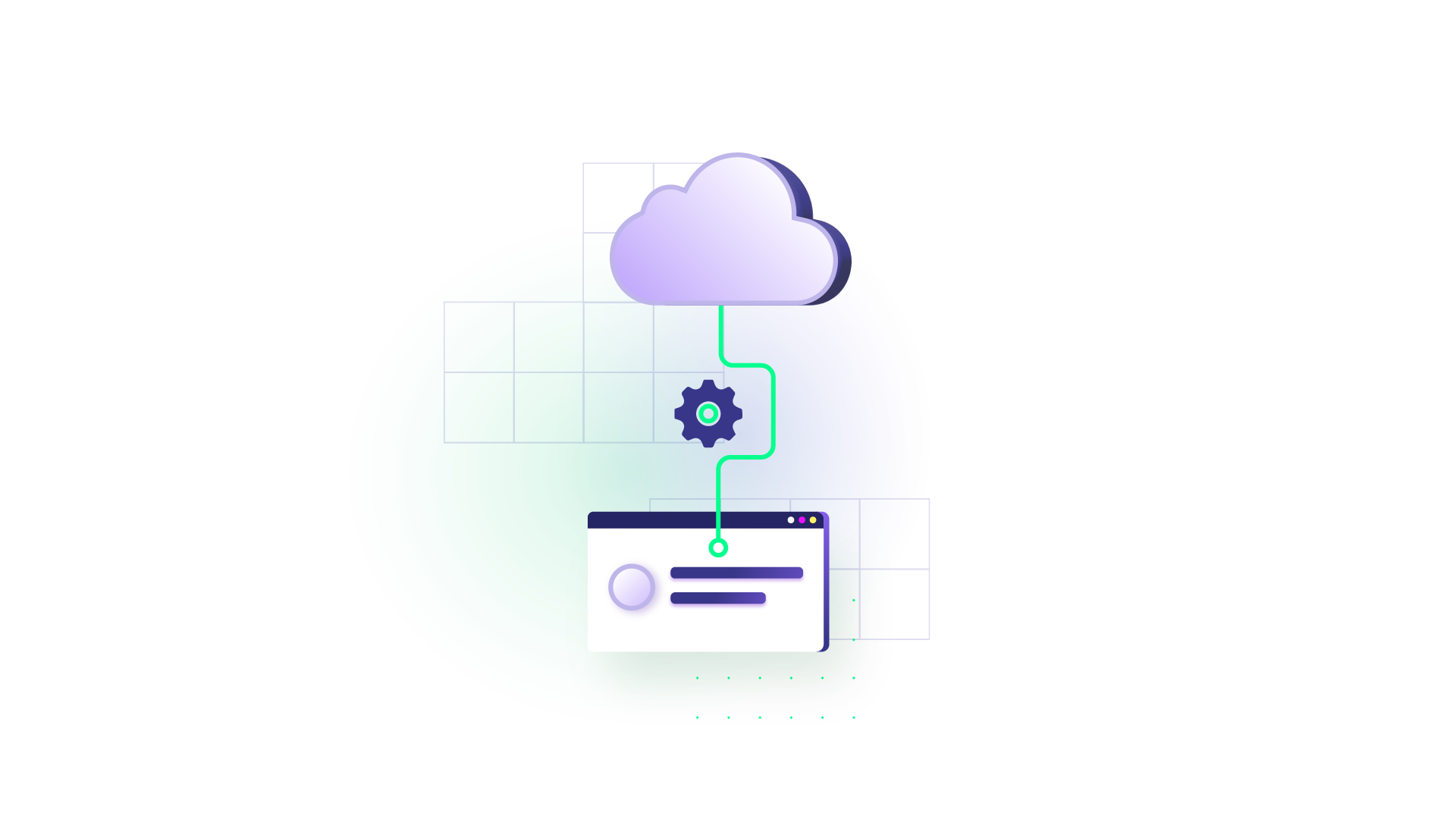
Most of these iPaaS providers’ roles are apparent to most. However, ESB and SOA deserve more elaboration.
ESB and SOA are both software architectures that have become mainstays of enterprise integration and integration patterns. ESB is used to distribute work among connected components of an application. As businesses became more service-driven, SOA emerged as the leading paradigm to optimize service delivery.
ESB is a way to effectively implement and manage SOA-based systems. In practice, SOA is the goal while ESB is the tool used to achieve software integration and deliver services with agility.
However, unlike current ESB investments, iPaaS is a less costly, more scalable, and decentralized solution. This decentralization is also a boon for organizations, enhancing security and reliability since there is no single point of failure.
Like most markets, iPaaS providers differentiate themselves with their product offerings and the market segment they target. While some court startups and small businesses with their offerings, others attempt to be the proverbial “jack-of-all-trades” by trying to appeal to the broadest clientele possible. Those in this category tend to include well-known iPaaS vendors and IT service providers.
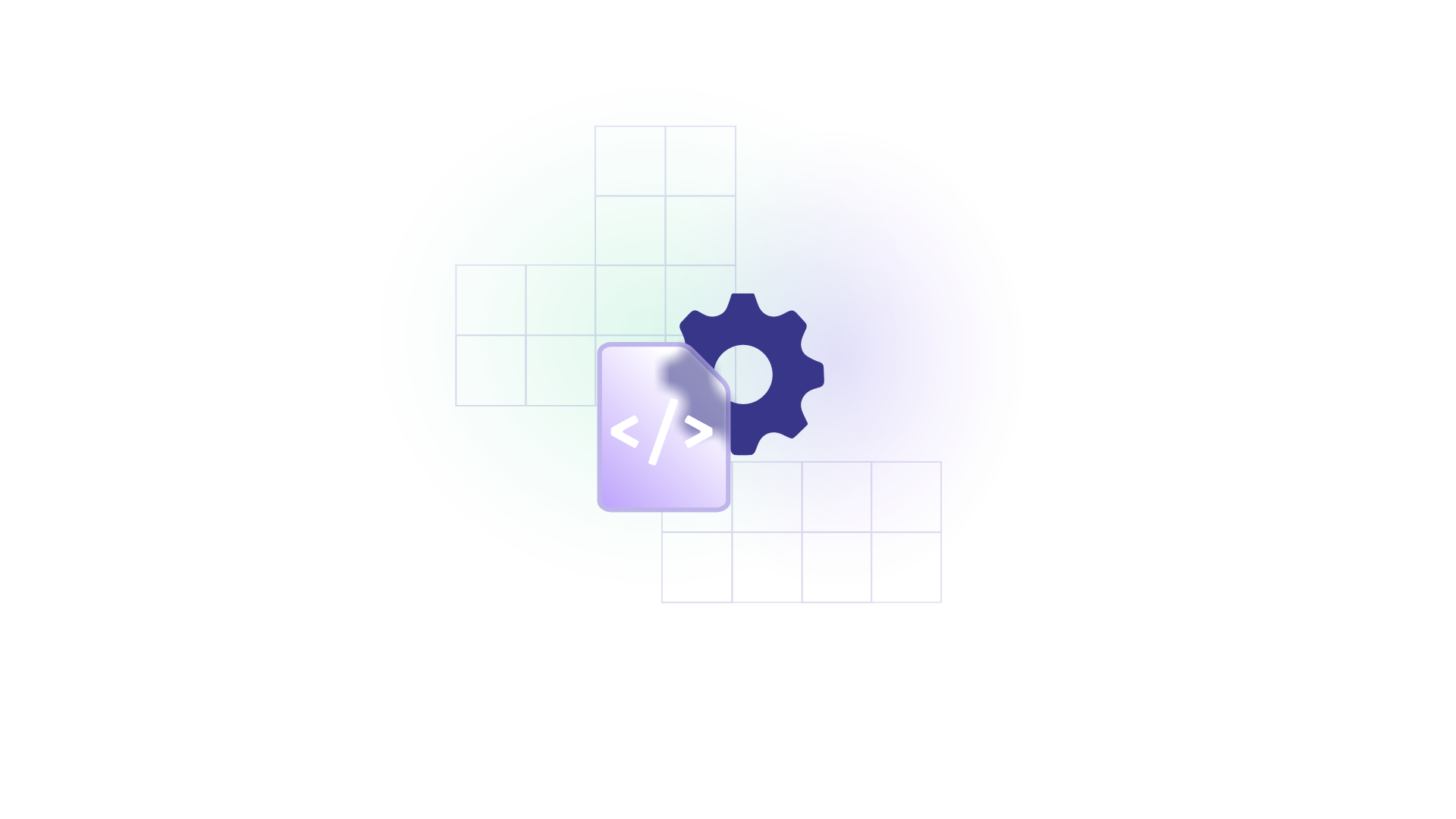
Companies with short-term integration needs are best served with iPaaS products that focus on cloud integration and e-commerce/B2B integration. But organizations that think long-term are better served by hybrid cloud computing models.
As a result, these companies favor iPaaS vendors with expertise in ESB and SOA because of the growing shift to hybrid environments and the ability to handle systematic integration in the cloud.
Most of these companies provide enterprise iPaaS services. However, as the iPaaS market matures, we are bound to see more domain-specific providers with integration solutions for specific customer authorities or niche portfolios.
iPaaS Examples
Various iPaaS solutions can be used to take advantage of the unique features of different software. Here are the best examples of iPaaS solutions for enterprises.
Zapier
Zapier is an iPaaS solution that allows you to share data between over 6000 applications, cloud services, CRMs, databases, marketing platforms, and communication tools.
Some Zapier features include Zaps, Tables, Canvas, Chatbots, Interfaces, and more. Other features include filters, formatters, and webhook connections.
Workato
Workato provides an iPaaS option that relies on recipes (pre-made instructions) to determine the rules guiding the integrations between systems and applications. Apart from integrations, Workato also handles API governance, management, and security.
In addition, enterprises can use Workato to build workflows and APIs. Triggers and Actions also dictate how the connectors work whenever an event occurs.
Exalate
Exalate is a bidirectional iPaaS solution used by teams to connect their applications, databases, and work management systems and share data securely.
Users can set up no-code connections using Exalate’s Basic mode or customize connections using the Groovy scripting engine. The other option is to use the AI Assist feature available in the code-based Script mode.
Exalate also handles bulk operations and provides event triggers for expressing how connections should work.
Oracle Integration Cloud
Oracle Integration Cloud Service is a lightweight iPaaS solution that enables you to connect your on-premise and cloud applications. It provides airtight security for all the applications and connectors.
One major advantage of using the Oracle Integration Cloud is that it provides you with a dashboard for monitoring the runtime performance and environment of all active connections.
You can also connect your system with native Oracle SaaS applications such as Sales Cloud, RightNow Cloud, and many more.
Dell Boomi
Boomi is an iPaaS integration that allows the connection of business processes through a centralized hub of default connectors and custom scripts.
Owned by Dell, Boomi supports API management, ETL (Extract, Transform, Load), B2B/EDI management, and a Master Data Hub for data visualization.
Informatica
Informatica is an AI-powered, cloud-based data management platform that automates workflows and business processes. Although best suited for data integration and management, it also provides an iPaaS framework for enterprises.
Some available Informatica features include Master Data Management (MDM) and data catalog. Enterprises can also connect applications and workflows using the native API integration.
Mulesoft
Mulesoft is an iPaaS solution that allows organizations to connect with third-party platforms and other solutions. Available features include Composer, IDP (intelligent document processing), AI, API Manager, etc.
As a Salesforce product, Mulesoft Anypoint Platform supports both on-premise and cloud-based connections as well as API governance, monitoring, and management.
Enterprises can use Mulesoft for their iPaaS needs by working with the no-code setup or adding some scripting alternatives with the low-code option.
SnapLogic
SnapLogic is an iPaaS tool that allows teams to integrate, automate, and orchestrate the flow of data and applications across your organization.
It uses pre-built connectors called Snaps for no-code integration. The AutoSync features also comes with automated, pre-packaged data pipelines.
You can use SnapGPT to translate user intent into actual integration use cases. The GenAI Builder, with the help of LLM, makes this a reality.
The Future of iPaaS
Relatively speaking, the iPaaS model is still in its early stages. The first iteration of iPaaS platforms was built with DevOps, systems architects, and other IT professionals in mind. However, as iPaaS adoption increases and buying decisions subsequently move away from IT departments, the next generation will become more user-friendly and less reliant on IT.
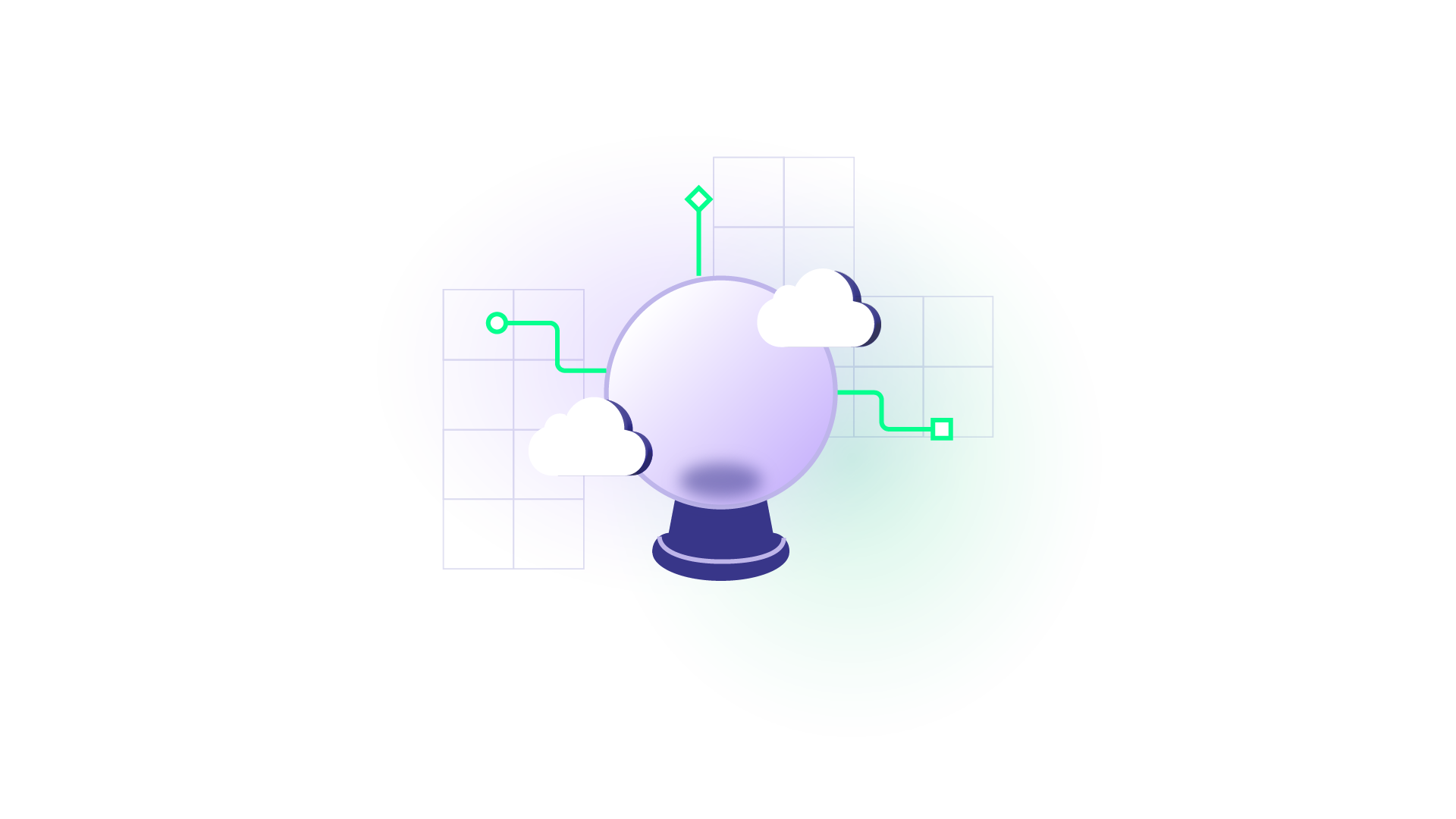
As organizations’ appetite for an integration strategy that holistically addresses the increasing complexity of their cloud operations grows, features like governance, lifecycle management of integrations, multitenancy, and self-provisioning will become more in-demand and commonplace.
Conclusion
To achieve a connected enterprise where business processes are easily automated and connected, you’ll need a reliable partner with experience in system and cross-platform integration.
Among many iPaaS solutions, Exalate is the only decentralized integration solution that is also an ideal partner for powerful integration across diverse platforms like Jira, ServiceNow, Salesforce, and so on.
There are various consumers of iPaaS solutions, ranging from SMBs that provide integrated solutions and system integrators offering IT-managed services to large enterprises juggling huge legacy and disconnected systems.
It is designed to provide seamless communication through bidirectional syncs, allowing teams to collaborate beyond company borders through effective cross-company integration.
Recommended Reads:
- Top 13 iPaaS Solutions
- eBonding Integration: The Ultimate Guide to Flexible Data Sync
- B2B Integration: The Comprehensive Guide
- CISCO Smart Bonding: An Introduction
- SaaS Integration Challenges and Benefits
- The Definitive Guide to Cross-Company Integrations for IT Professionals
- ITIL 4 and Service Management: The Right Choice for Your Service Management Approach
